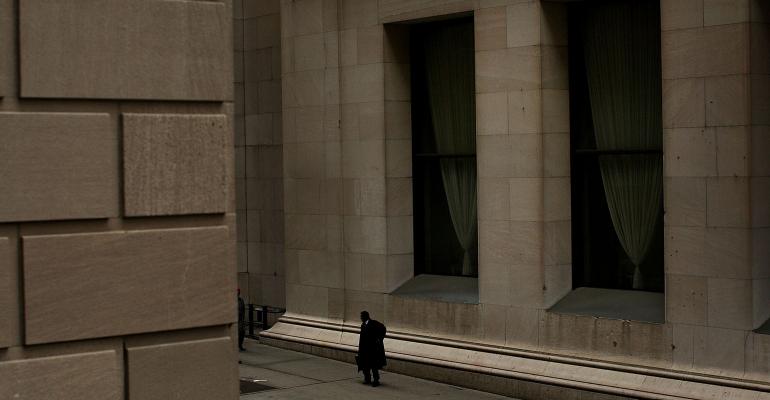By Alexandra Harris and Liz Capo McCormick
(Bloomberg) --Regulators’ effort to stamp out risk in the $2.6 trillion U.S. money-fund industry is creating unintended ripple effects across financial markets, with far-reaching consequences for companies and investors.
Far less cash than anticipated has returned to the higher-yielding slice of the money-fund world, after the overhaul that took effect in October led to a $1 trillion exodus from what are known as prime funds. They’ve been the principal buyers of the commercial paper that companies and both foreign and domestic banks have sold for decades to obtain short-term U.S. dollar-denominated financing.
By squelching demand from prime funds, commercial-paper rates relative to other money-market securities have risen, and are now at the highest levels since the financial crisis, causing borrowers to seek new sources of funding like the short-term securities lending market. Investors are also feeling the pinch -- most money funds are stuck with Treasury bills offering paltry rates. What’s more, the massive shift toward funds that can only buy the safest U.S. debt has created the potential for a bottleneck if Congress is unable to resolve long-simmering disputes related to the nation’s debt ceiling.

“The biggest losers are financial institutions,” said Anthony Carfang, a Chicago-based managing director at Treasury Strategies, a consultant for corporations and financial-services providers. “U.S. financials and non-financials have also been hurt. There are very few U.S. corporations getting funding from prime funds.”
The commercial-paper market is a shadow of its former self, with foreign financial issuance up only about $20 billion since November, as overseas institutions gravitate to high-quality, short-term government assets to secure U.S. dollar funding. Non-U.S. banks lost $555 billion of U.S. dollar funding from prime funds since December 2015, according to the Bank for International Settlements’ Quarterly Review published March 6.
The number of AA rated financial commercial-paper issues with maturity longer than 80 days has plummeted. Six issuers tapped the market March 29, compared with as many as 95 a day in March 2016, Federal Reserve data show.

“We’re in the middle of a long-term shakeup of dollar-funding markets,” said Blake Gwinn, a U.S. rates strategist with NatWest Markets in Stamford, Connecticut. “We’re moving from a regime that lasted a decade or so and finding our footing for the next 10 to 20 years.”
The catalyst is U.S. regulatory efforts to prevent a repeat of the run on money-market funds that took place during the 2008 financial crisis, when the $62.5 billion Reserve Primary Fund had to “break the buck” due to losses on debt issued by Lehman Brothers Holdings Inc. That caused a panic among investors in other funds who went on to yank about $200 billion in about two days, nearly freezing credit markets.
The changes included institutional prime funds abandoning the long-held tradition of having asset values locked at $1-per-share. Holdings in prime funds fell to a record low $373 billion after the reforms went into effect in October, ICI data show. Since the implementation deadline, total prime fund assets have only rebounded by about $25 billion. Most of the prime outflows ended up in government-only funds, which were exempt from the changes.
Among foreign institutions, Japanese banks’ exposure to prime funds fell to $44.9 billion in February from $174.6 billion in October 2014, while French banks’ exposure dropped to $62.1 billion from $165.2 billion, Securities & Exchange Commission data show. Prime funds slashed U.S. bank holdings to $53.9 billion from $233.2 billion.

As an alternative, non-U.S. banks have gained about $140 billion of funding via repurchase agreements with government money funds, according to the BIS. Ninety-day commercial-paper rates are about 1 percent, compared with 0.9 percent for similar-maturity repos.
“There are other investors out there who are willing to buy bank paper -- especially as spreads and rates overall have gone up a bit” given the Fed tightening, said Oskar Rogg, head of Treasury for the Americas at Credit Agricole CIB in New York. “Other counterparties, using other vehicles like separately managed accounts and offshore funds, have been willing to provide funding to banks.”
While the SEC changes have reduced the odds of a repeat of a 2008-style credit-induced crisis, other unintended risks have surfaced, such as the concentration of money in government funds. Any startling event, such as another fight over extending the nation’s borrowing capacity could serve as a trigger for disruptive moves out of the sector.
“Wherever you have those big dollars moving around, they themselves are a risk,” said Peter Crane, president of Westborough, Massachusetts-based Crane Data LLC. “You put a bunch of 800-pound gorillas in a room, and if all of a sudden everyone wants to get out, they are going to break down a wall.”
One silver lining for prime funds is the widening gap between yields on the two types of funds, which could eventually lure back more cash.
But even if some money returns, it will only be a fraction of what was lost, because some investors, including sweep accounts, are required to place their cash in money funds with a constant net asset value. Other fund companies, such as Fidelity Investments, which converted their institutional prime money markets to government-only, are unlikely to revert.
“The one trillion that left will not all come back,” Carfang said. “Not all of it can come back.”
To contact the reporters on this story: Alexandra Harris in New York at [email protected] ;Liz Capo McCormick in New York at [email protected] To contact the editors responsible for this story: Boris Korby at [email protected] ;Jeremy Herron at [email protected] Dave Liedtka, Mark Tannenbaum





